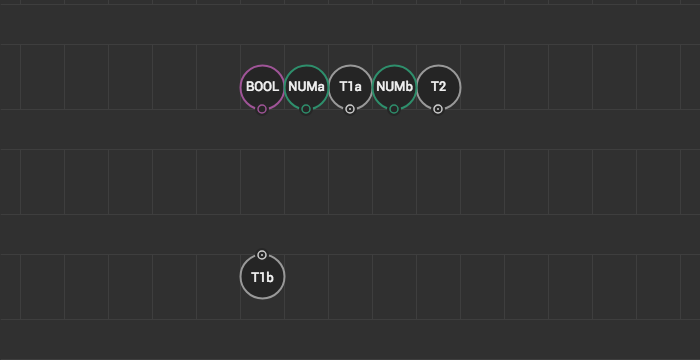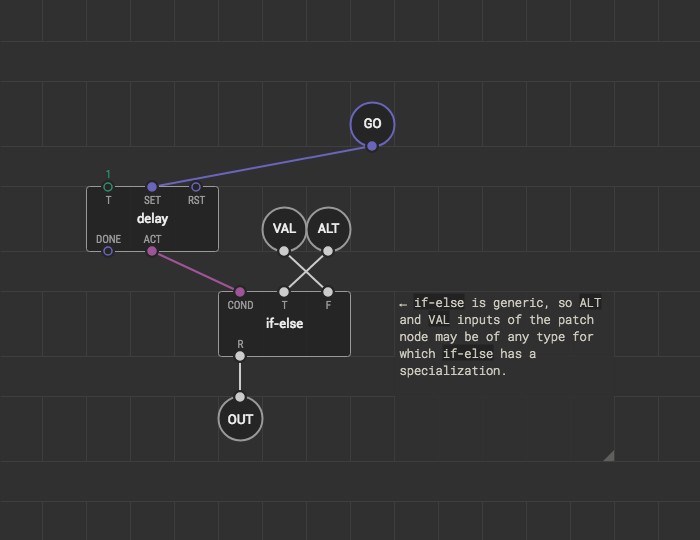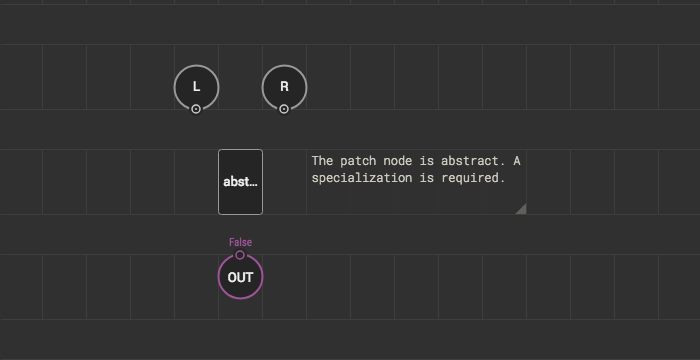Creating Generic Patch Nodes
If you’re going to make a patch node that should work regardless of the concrete data types on its pins, making your patch node generic is the way to go. Otherwise, you’d have to provide users with a repetitive set of nodes which differ only in pin types but act in the same way:
foobar-numberfoobar-booleanfoobar-string
To follow the guide you have to know patch node creation basics. Also, make sure you’re familiar with the generic nodes concept and understand how the resolution process works.
Generic terminals #
The process of creating a generic patch itself is almost the same as creating a regular patch. The difference is that in case of a generic patch node, instead of placing terminals of specific types, you use:
xod/patch-nodes/input-t1xod/patch-nodes/input-t2xod/patch-nodes/input-t3xod/patch-nodes/output-t1xod/patch-nodes/output-t2xod/patch-nodes/output-t3
Your patch may contain generic terminals only or mix regular and generic terminals.

Composition #
The most straightforward way of implementing a generic patch is to build it out of other generic nodes. That is, make it a common XOD patch node.
Let’s implement a generic node which always passes an input value to its output, but once a pulse is triggered it outputs another input’s value for one second.

If you can find all the nodes required to compose your patch node, no extra steps are necessary. You and users of your library can start using the node right away.
Abstract marker #
If it is impossible to express a generic patch node as a pure composition, you have to mark it abstract. To make a patch abstract, place a xod/patch-nodes/abstract marker node on it.

That forces XOD to search for a matching specialization patch when it processes the program. If a necessary specialization is not found, an error will show up, and the program will fail to transpile. Which is a good thing since it shows a xoder what’s missing so that he can provide an implementation for himself. See generics resolution process for details.
Specialization patches #
For a generic patch, you may provide several specialization patches. XOD searches for a matching specialization every time it encounters a generic node. It replaces the generic node with a specialized one if found.
The specialization patch is a regular patch, which either:
- conventionally named
<basename>(<t1>,<t2>,<t3>)wherebasenamedefines the base generic patch name andt𝑛define particular types for which the specialization was created. For exampleif-else(number)is a specialization for a generic patchif-elsefor cases when anumberis bound to its inputs. - named just
<basename>, when it’s a specialization for a custom type defined within the same library. For examplexod-dev/w5500/open-tcpis a specialization for a generic patchxod/net/open-tcpfor cases when axod-dev/w5500/w5500-inetis bound to one of the inputs.
Note, you can create specialization patches for generic patches created in other libraries, and XOD will pick them up correctly. That way, you can improve others’ work by making missing or optimized implementations.
Rules #
To let XOD resolve generic nodes properly, you have to follow some rules while creating generic patch nodes and their specializations:
- If a patch contains generic output terminal, a generic input terminal of the same generic type should present. In other words, if you use
output-t2, theninput-t2should appear as well. - There should be no more than a single specialization patch for a particular generic patch. Otherwise, the choice will be ambiguous, and an error will be shown. A xoder will be forced to resolve manually, that is choose specialization by hand.
Summary #
If you’re creating a generic patch node, you have a few options:
- Create a single generic patch node and implement it as a composition of other nodes.
- Create the base generic patch node and mark it abstract. Then create specialization patches for each supported type combination which in their turn are implemented in XOD or C++.
- Create the base generic patch node as a composition, and add a few specialization patches for better performance or wider type support.